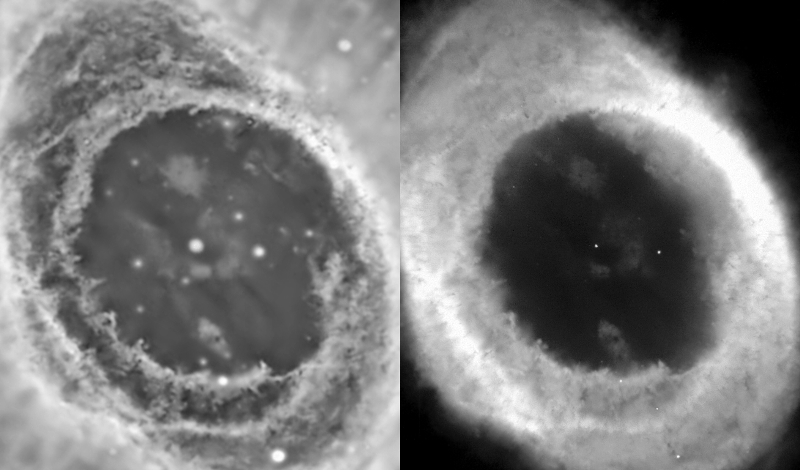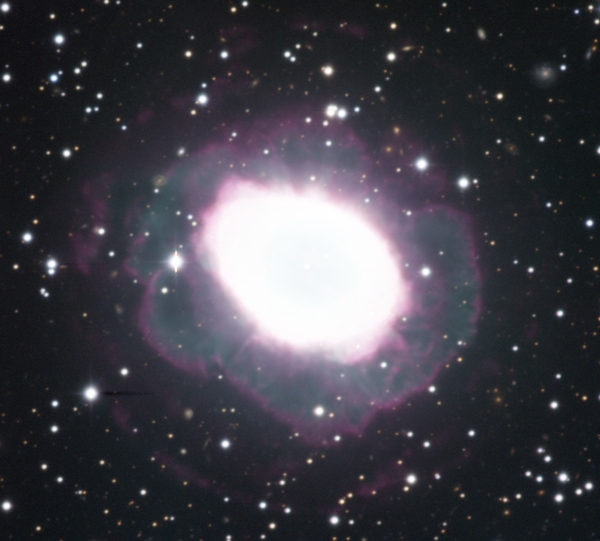Messier 57 with Calar Alto Observatory
By Vicent Peris (OAUV/CAHA/PTeam)
Introduction

Click to download a full-resolution image.
Image Caption and Credits: Image of the Ring Nebula in Lyra from the Documentary Photo Gallery of Calar Alto Observatory (RECTA/CAHA/DSA). Vicent Peris (DSA/OAUV), José Luis Lamadrid (DSA/CEFCA), Jack Harvey (DSA/SSRO), Steve Mazlin (DSA/SSRO), Ana Guijarro (CAHA). Entirely processed with PixInsight 1.5. Click on the image to download a full-resolution version (image scale: 0.15 arcsec per pixel)
This portrait of the Messier 57 nebula in Lyra is the second RECTA/CAHA/DSA collaboration. The data were acquired mainly through the 1.23 meter Carl Zeiss telescope at Calar alto Observatory. It is a rather long exposure taken during several nights from July to September 2009:
-
18 hours of optical narrowband data in the Hα and OIII lines. These data were acquired entirely through the 1.23 meter telescope, and they provide an extreme deepness to the nebula’s halo. The Hα filter has a bandpass widht of 5 nm (it transmits part of the NII lines), while the OIII one has a bandwidht of 9 nm. All subexposures were 20 minutes long.
-
3 hours of broadband data with standard photometric Johnson BVR filters. These data were acquired through the 3.5 meter telescope with the LAICA camera. It gives the required deepness to the background field, as well as the high resolution required to show all the detail in the halo and inner disk. Subexposures were 2 minutes in R, 3 minutes in V and 2 minutes in B. All the data were acquired in a white night.
-
45 minutes of infrared narrowband data, acquired through the 3.5 meter telescope and the Omega-2000 IR camera. The infrared image was taken through a filter centered in the molecular hidrogen emission at 2.12 microns. All subexposures were rather short (45 sec), as is usual with ground-based IR observations.
Image Calibration and Registration
The whole data set was calibrated manually with the ImageContainer and PixelMath tools in PixInsight. The PixelMath formula is rather simple:
($T - bias)*Avg(flat)/flat
Where $T is the target image being calibrated, bias is the master bias frame, and flat is the master, bias subtracted, flat frame.
Image registration and integration were done automatically with the StarAlignment and ImageIntegration tools, respectively.
Color Mapping and Calibration
The figure below shows the M57 nebula as seen through the six filters used.
To combine the optical narrowband components with the broadband ones, we introduced the different emissions in the BVR images. The R filter transmits only the Hα line. The B and V filter transmit in different proportions the OIII and Hβ emission lines. Therefore we introduced the OIII and Hα images in both filters with varying weights.
Finally, the infrared image was processed separately and introduced in the processed optical image, as both images represent very different nebula structures.
This 6-channel mixing gave us the resulting emission line tones:
-
The OIII emission has a teal tone.
-
The combined Hα and Hβ gives a nearly violet emission. This gives us a good differentiation between optical hidrogen emission and the infrared one.
-
Molecular hidrogen IR emission is represented as pure red.
All these operations were carried out with the PixelMath tool.
Color calibration was performed with the ColorCalibration tool, taking the whole light of the objects in the image as a white reference.
Deconvolution
There are two decisive steps to process this image: deconvolution of the high-signal areas, and dynamic range compression. Deconvolution was carried out with the regularized Richardson-Lucy algorithm, and it was applied only to the inner disk, where we have enough signal-to-noise ratio.

The contrast between the ring and the halo of the nebula is very steep, so the mask to select the areas with enough signal is almost a binary mask including only the ring and the central hole. This can be better understood if we make a 3-D plot of the linear Hα image to the left.
Click to enlarge
This 3-D plot has been produced with the 3DPlot JavaScript script in PixInsight (3DPlot script version 1.3 by Andrés Pozo, David Serrano and Juan Conejero). It shows that even the hole at the center of the nebula's main disk has a very steep illumination fall with respect to the ring.
Deconvolving the outer halo (barely visible in the graphs due to its extreme faintness) would be impossible. Even if we deconvolve those areas with noise regularization, the wavelet-based algorithm would not detect any structure to deconvolve, as there isn’t enough signal strenght.
It is also interesting to compare our red image with the one taken by the Hubble Space Telescope ten years ago.

Unfortunately, the HST red image is heavily clipped, which doesn't help the comparison. This side by side comparison shows the extremely good performance of the regularized Richardson-Lucy deconvolution algorithm, as well as the movement of nebula structures during this 10 year period.
Dynamic Range Compression
The inner nebula disk is extremely bright, compared to the outer halo. For that reason the dynamic range compression procedure is of crucial importance. Below we can see the stretched image prior to dynamic range compression:

Click to enlarge
The dynamic range compression and processing was carried out with the HDR-Wavelet algorithm, as well as with the techniques described in the NGC 7331 processing notes. A 3-D plot of the above stretched image clearly shows the illusion that we create when we stretch the data.
It seems that the center hole of the nebula has approximately the same illumination level as the ring, and it seems that there’s only a tiny part of the actual contrast between the disc and the outer halo.
Frequently Asked Questions
Why are the stars somewhat elongated?
The LAICA camera has a special arrangement of CCD image sensors. It has four CCDs separated by gaps of nearly the same size as the sensors themselves, as shown by this image. This yields a completely contiguous field coverage by pointing the telescope at four different locations. In this way the camera can cover one square degree without any gap. The drawback of this configuration is that each CCD is just at one border of the telescope's field of view, where the stars are not perfectly circular.
Why have you left some bloomings uncorrected?
We leave a blooming in the image when data integrity is compromised. We haven't done any cosmetic repairs that can compromise integrity of visible image structures, or that require guessing unavailable data to the point of arbitrary creation of nonexistent image structures.
Why does the center of the nebula seem sharper than the rest of the image?
When you have very high signal levels in the image, you can reach a point where you can apply some delicate image restoration algorithms. In this case, deconvolution has been applied to the higher signal areas of the image exclusively (excluding the stars to avoid the Gibbs effect, or ringing artifacts). Leaving the image without the deconvolution step would limit the documentary value of this photo.
How can I understand the colors of this image?
In the nebula, each hue represents a different chemical composition. The teal color is indicative of presence of doubly-ionized Oxygen. The violet color reveals the presence of the combined Hydrogen-α and β emission lines. Finally, the red color shows the molecular Hydrogen (H2) infrared emission.
Take into account that the inner nebula is extremely bright compared to the outer halo. In this photo, the inner nebula has high luminance values; this means that the redder emission components are perceived as pink. But if you measure chrominance values on these areas, you will see that the red hues are preserved. The whole image wouldn't be coherent at all with low luminance values in the inner nebula.
Comparing this image with the corresponding image by the Hubble Space Telescope (HST), it seems that you have some false details. Are they really artifacts?
The HST image and our image have been done with different filters and processing techniques. When we processed this image, we took special care at enhancing Hydrogen structures. Part of the Hydrogen data were transferred to the luminance, taking care to preserve pixel hues. If you compare the red channel from both pictures, you will see that there are no artifacts at all.


